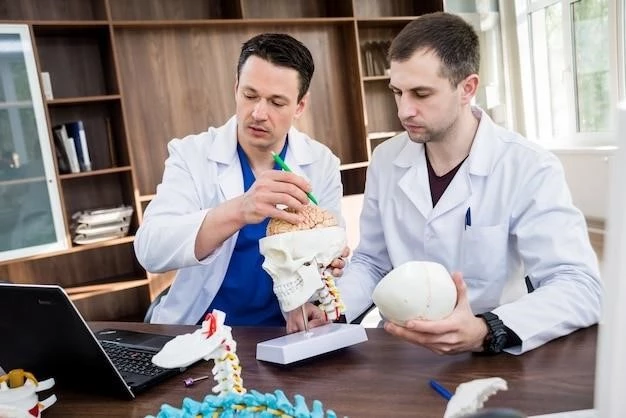Understanding Desbuquois Syndrome
Desbuquois Syndrome, a rare genetic disorder, is characterized by short stature, skeletal abnormalities, joint stiffness, facial features, and developmental delay. This article aims to provide insights into the clinical features, developmental aspects, genetic basis, diagnosis, orthopedic complications, and treatment of Desbuquois Syndrome.
Introduction to Desbuquois Syndrome
Desbuquois Syndrome, a rare inherited disorder first described by French pediatrician Robert Desbuquois in 1966٫ falls under the umbrella of skeletal dysplasias. It is characterized by a constellation of physical and developmental abnormalities٫ including short stature٫ joint stiffness٫ facial features such as a flat midface and prominent eyes٫ and skeletal anomalies like dislocations. Patients with Desbuquois Syndrome often experience growth retardation٫ leading to a form of dwarfism. The syndrome is also associated with intellectual disability and various orthopedic complications. Diagnosis of Desbuquois Syndrome can be challenging due to its overlapping features with other genetic disorders٫ necessitating a multidisciplinary approach involving geneticists٫ pediatricians٫ orthopedic specialists٫ and other healthcare professionals. This introductory section sets the stage for a comprehensive exploration of the clinical features٫ developmental aspects٫ genetic underpinnings٫ diagnosis٫ orthopedic challenges٫ and available treatment strategies for Desbuquois Syndrome٫ providing valuable insights for medical professionals٫ researchers٫ and families affected by this complex condition.
Clinical Features of Desbuquois Syndrome
Desbuquois Syndrome manifests a spectrum of clinical features that contribute to its diagnostic complexity. Individuals with this syndrome typically present with short stature, often classified as disproportionate dwarfism, wherein the trunk is shorter than the limbs. Joint stiffness, especially in the hips, knees, and elbows, is a common feature, leading to restricted mobility and potential orthopedic complications. Facial characteristics include a flat midface, a broad and flat nasal bridge, and notable eye prominence.
In addition to skeletal abnormalities such as dislocations, patients may exhibit certain dermatological features like soft and doughy skin. Developmental delay is a hallmark of Desbuquois Syndrome, with affected individuals experiencing intellectual disability to varying degrees. Growth retardation may become apparent in early childhood, further contributing to the distinctive short stature observed in these patients.
It is essential for healthcare providers to recognize the array of clinical features associated with Desbuquois Syndrome to facilitate timely diagnosis and appropriate management. Understanding the distinct phenotypic traits of this rare genetic disorder can aid in differentiating it from other conditions with overlapping symptoms, ensuring that affected individuals receive tailored care and support.
Developmental Aspects of Desbuquois Syndrome
Developmental aspects play a crucial role in the comprehensive understanding of Desbuquois Syndrome. Individuals with this rare genetic disorder often exhibit developmental delay, encompassing motor, cognitive, and speech domains. The impact of developmental delay can vary widely among affected individuals, influencing their overall quality of life and functional capabilities.
Motor development in Desbuquois Syndrome may be affected by joint stiffness and skeletal abnormalities, leading to challenges in gross and fine motor skills. Children may experience delays in reaching developmental milestones such as sitting, crawling, and walking independently. Occupational and physical therapy interventions are essential to support optimal motor development and enhance mobility in these individuals.
Cognitive development is another critical aspect influenced by Desbuquois Syndrome. Intellectual disability is a common feature, ranging from mild to severe levels of impairment. Educational interventions tailored to the specific needs of individuals with intellectual disability are imperative to promote cognitive development, communication skills, and social interactions.
Speech and language development can also be impacted by the syndrome, with some individuals experiencing delays in speech production, language comprehension, and articulation. Speech therapy plays a vital role in addressing communication challenges and promoting expressive and receptive language skills.
Understanding the developmental aspects of Desbuquois Syndrome is fundamental for healthcare professionals, educators, and caregivers involved in the care of affected individuals. Early detection of developmental delays, coupled with timely interventions and multidisciplinary support, can significantly improve outcomes and enhance the overall development and well-being of individuals living with this complex genetic condition.
Genetic Basis of Desbuquois Syndrome
Desbuquois Syndrome is primarily caused by genetic mutations affecting the development of skeletal tissues during embryogenesis. The syndrome exhibits autosomal recessive inheritance, meaning that affected individuals inherit two copies of the mutated gene, one from each parent. The genetic mutations associated with Desbuquois Syndrome are typically found in genes involved in the regulation of skeletal growth and development.
One of the key genes implicated in Desbuquois Syndrome is CANT1 (Calcium-Activated Nucleotidase 1), located on chromosome 17. Mutations in the CANT1 gene disrupt the normal function of the enzyme it encodes, leading to abnormal skeletal growth and development. This disruption results in the characteristic features of Desbuquois Syndrome, including short stature, joint stiffness, and skeletal abnormalities.
In addition to mutations in the CANT1 gene, rare cases of Desbuquois Syndrome have been linked to mutations in the XYLT1 gene, which plays a role in the synthesis of proteoglycans essential for skeletal development. These genetic alterations can impact the structure and function of proteoglycans, contributing to the skeletal anomalies observed in individuals with Desbuquois Syndrome.
Understanding the genetic basis of Desbuquois Syndrome is essential for diagnosing the condition, providing genetic counseling to affected families, and exploring potential therapeutic targets. Advances in molecular genetics and genomic sequencing have facilitated the identification of causative mutations, enabling healthcare professionals to offer personalized care and management strategies tailored to the underlying genetic etiology of this rare genetic disorder.
Diagnosis of Desbuquois Syndrome
Diagnosing Desbuquois Syndrome involves a comprehensive evaluation of clinical features, genetic testing, and imaging studies to confirm the presence of characteristic signs and symptoms associated with the condition. Medical professionals typically conduct a thorough physical examination to assess the patient’s stature, skeletal structure, joint mobility, and facial characteristics.
Imaging modalities such as X-rays, magnetic resonance imaging (MRI), and skeletal surveys may be utilized to visualize skeletal abnormalities, joint dislocations, and other orthopedic manifestations of Desbuquois Syndrome. These diagnostic tools play a crucial role in identifying specific skeletal dysplasias and guiding treatment decisions;
Genetic testing is a key component of the diagnostic process for Desbuquois Syndrome. Molecular genetic testing can identify mutations in the CANT1 or XYLT1 genes٫ confirming the genetic basis of the syndrome in affected individuals. Whole exome sequencing and targeted genetic testing are often employed to detect pathogenic variants associated with Desbuquois Syndrome.
Given the rarity and complexity of Desbuquois Syndrome, obtaining a definitive diagnosis may require the expertise of geneticists, pediatricians, orthopedic specialists, and other healthcare professionals experienced in diagnosing rare genetic disorders. Differential diagnosis is crucial to distinguish Desbuquois Syndrome from other skeletal dysplasias and genetic conditions with similar phenotypic features.
Early and accurate diagnosis of Desbuquois Syndrome is essential for initiating appropriate medical management, monitoring orthopedic complications, and providing tailored support services to improve the quality of life for individuals affected by this rare genetic disorder. Collaborative efforts among various healthcare disciplines are instrumental in ensuring a timely and precise diagnosis of Desbuquois Syndrome.
Orthopedic Complications in Desbuquois Syndrome
Individuals with Desbuquois Syndrome are susceptible to a range of orthopedic complications stemming from the skeletal abnormalities and joint stiffness characteristic of the condition. Joint dislocations, particularly in the hips, knees, and elbows, are common occurrences in affected individuals and can lead to pain, instability, and functional impairment.
The presence of joint stiffness and restricted mobility in Desbuquois Syndrome predisposes individuals to an increased risk of contractures, wherein joint movements become limited due to muscle and soft tissue tightness. Contractures can affect multiple joints, complicating daily activities and necessitating targeted interventions to improve range of motion.
Scoliosis, a lateral curvature of the spine, may develop in some individuals with Desbuquois Syndrome, further contributing to musculoskeletal issues and postural abnormalities. Monitoring for scoliosis and implementing appropriate orthopedic management strategies are crucial in preventing progression of spinal deformities and optimizing spinal alignment;
Orthopedic interventions such as physical therapy, occupational therapy, and orthopedic surgeries may be recommended to address orthopedic complications associated with Desbuquois Syndrome. Physical and occupational therapy aim to improve joint flexibility, muscle strength, and functional abilities, whereas orthopedic surgeries may be indicated to address severe joint dislocations or correct skeletal deformities.
Regular orthopedic assessments and multidisciplinary collaborations are vital in managing orthopedic complications in individuals with Desbuquois Syndrome. By addressing musculoskeletal issues promptly and comprehensively, healthcare providers can enhance the quality of life, functional independence, and mobility of individuals affected by this rare genetic disorder.
Treatment and Management of Desbuquois Syndrome
The management of Desbuquois Syndrome involves a multidisciplinary approach aimed at addressing the diverse medical, developmental, and orthopedic needs of affected individuals. Treatment strategies are tailored to manage the specific symptoms and complications associated with the syndrome, focusing on improving quality of life and enhancing functional outcomes.
Orthopedic interventions play a central role in the treatment of individuals with Desbuquois Syndrome. Physical therapy and occupational therapy programs are designed to optimize mobility, muscle strength, and joint flexibility, thereby enhancing functional abilities and promoting independent living. Orthopedic surgeries may be considered for addressing severe joint dislocations, spinal deformities, or limb discrepancies.
Regular monitoring and management of orthopedic complications, such as joint dislocations, contractures, and scoliosis, are essential to prevent long-term musculoskeletal problems and maintain overall health and well-being. Orthopedic specialists work closely with other healthcare providers to coordinate care and ensure holistic management of the orthopedic aspects of Desbuquois Syndrome.

In addition to orthopedic care, individuals with Desbuquois Syndrome may benefit from early intervention services, educational support, and speech and language therapy to address developmental delays and intellectual disabilities. Psychosocial support and genetic counseling are integral components of the comprehensive care plan, offering guidance and resources to affected individuals and their families.
As research and clinical understanding of Desbuquois Syndrome continue to evolve, targeted therapies and interventions may emerge to address specific genetic mechanisms underlying the condition. Collaborative efforts among healthcare professionals, researchers, and advocacy organizations are essential in advancing knowledge about the syndrome and improving diagnostic and therapeutic strategies.
